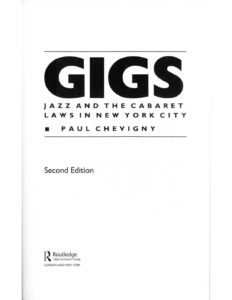Constitutional Law Attorney and Counsel for Plaintiffs in Chevigny and Festa Cases book on the Cabaret Law and litigation to eliminate restrictions against music.
Chevigny’s book recounts his litigation against the City in the Chiasson 1 and Chiasson 2 cases (but not the Festa case which was subsequent) and the aftermath and attempts to modify the City’s zoning laws from 1985 to 1990. The book is invaluable in providing legislative history background to the 1989-1990 amendments to the Zoning Resolution adding the restrictions against dancing and live music, although in certain districts, allowing live music as of right (although, in many districts, still subjecting live music to the requirement of Special Permit.)
As to the dancing restrictions added, Chevigny states at page
He meant that the proposal did nothing for anybody but musicians. As City Planning had narrowed it, the proposal no longer aided comedy, or dancing as a performance, not to speak of social dancing. Because the fight was led by musicians, it was distorted from the point of view of the clubs as well as of arts other than music. During our discussions in John Glasel’s office, we had given up trying to include comedy and dancing within the purview of our proposal, because we knew so little about the zoning effects of dancing, much less of comedy. The lack of organization among the clubs had had its effect; if had had any request from a comedy club, indeed from the representatives of any of the arts, for that matter, we could have reworked the proposal. I never had such a request. We just carried out the fight as best we could on behalf of musicians. The result was that in the final proposal, City Planning had to add a footnote that it was working on parallel zoning proposals for other sorts of entertainment.
Professor Chevigny, though, perhaps underestimated the districts that would still require Special Permits for live music. See Special Permits.
Chevigny devotes seven pages (139-146) describing how in practice Special Permits were of little meaning, for example at page 141.
According to City Planning, the Board has received only five requests for such club permits, granting four, in the two and a half years before June, 1987; none in Manhattan, and none for music-only clubs. I thought I could see why; the process was arcane, expensive and unlikely to be successful in a great many cases.
Due to the complexity of drafting, it is not clear that the musician’s union understand the extensive requirement of Special Permits.
One Reservation as to Chevigny’s book.
The book is well researched, but, in one instance, Professor Chevigny relies upon personal opinion, rather than researched documentation, and that is his off-hand statement that the 1926 Cabaret Law was directed at social mixing and black music and dance.
That instance is his opinion at page 57 that:
The ordinance must have been largely directed at the black music and dance that was performed in the Harlem clubs , as well as the social mixing of races that was part of “running wild,” because in 1926, the “jazz” about which the aldermen complained was being played mostly in Harlem.
Contemporary sources such as newspaper articles provide the context to “running wild”.
This single sentence of opinion unfortunately then became the basis for pronouncements by many as being a researched documented history that the Cabaret Law was racist in its inception and has found its way into publications even the New York Times. But, Chevigny cited not research to support his opinion, as indicated by the lack of notes to this chapter. Moreover, his statement that the “jazz” was played mostly in Harlem is contradicted by the number of white musicians who played jazz in the twenties, by the white flappers, etc. There just in no support in music history for this view. His opinion is even contradicted by the statement on the prior page 55 that
In 1960, during an important cabaret-law scandal , the New York Post interviewed Elmer Rogers, a lawyer who had helped to draft the original ordinance. He said, “To understand why this was enacted, you must recall that during Prohibition better than 90 per cent of the speakeasies were controlled by racketeers.”
Whether Chevigny argued this view to the courts in Festa and Chiasson I and Chiasson II, these courts did not adopt this view of racism, notwithstanding the miscite by Muchmore which then found itself into the Muchmore’s court’s decision.
The book in all other respects, especially as to legal matter, is a tremendous and essential resource for its description of zoning and the related politics. For anyone involved in the reform of the zoning laws in post 2017, this book is a must read, for the political and social background to music and dancing restrictions has changed very little.
Below, as a matter of fair use, we reproduce the relevant 4 pages from the book and the notes for those pages, showing the absence of any cited authority for this opinion.
Gigs: Jazz and the Cabaret Laws in New York City (Routledge Studies in Law, Society and Popular Culture) 2nd Edition 2005.
